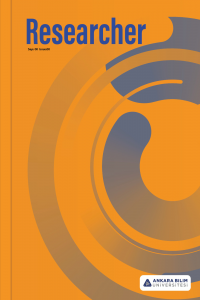Kurumsal İtibarın Ölçülmesi: İki Özel Hastane Örneği
Hastanelerdeki iç ve dış paydaşların kurumsal itibara ilişkin algılamalarının tespit edilmesi ve bu paydaş gruplarının kurumsal itibarla ilgili algılamaları arasında bir fark olup olmadığının belirlenmesi amacıyla bir akredite ve bir akredite olmayan iki hastane paydaşları ile gerçekleştirilen bu çalışma kapsamında; 346 yönetici-çalışan, 384 hasta-hasta yakını ve 83 tedarikçiden veri toplanmıştır. Faktör analizi sonucuna göre paydaşların kurum itibarına yönelik algılamalarının birden fazla alt boyutu içerdiği belirlenmiştir. Özellikle, çalışma ortamı boyutu diğer bileşenlere göre daha ayırt edici algılanmış ve birinci faktörü oluşturmuştur. Toplam varyansın %29’unu açıklayan bu boyutu, %8,6 ile toplumsal sorumluluk, %5,1 ile çalışan kalitesi, %4,8 ile itibar algısı, %4,1 ile finansal sağlamlık %3,6 ile yönetim kalitesi izlemiştir. İç paydaşlar, çalışan kalitesi ve toplumsal sorumluluk alt boyutlarını toplam puan ortalamasının üstünde değerlerle puanlarken, dış paydaşlar ise çalışan kalitesi ve çalışma ortamı alt boyutlarını toplam puan ortalamasının üstünde puanlamışlardır. Görüldüğü gibi kurumsal itibar ve bileşenleri farklı paydaşlar tarafından farklı boyutlarla algılanmaktadır. Farklı paydaşların kurumsal itibarla ilgili farklı bilgilere ihtiyaç duyması ve bu bilgilerin sonucunda kurumla iletişim kurma, kurumu etkileme olasılıkları ve kuruma yönelik algılarının farklılaşması; kurumsal itibarın hangi unsurlara göre oluşturulacağı ve yönetileceği konusunda yöneticilere ışık tutması açısından önemlidir
Anahtar Kelimeler:
İtibar, Kurumsal İtibar, Özel Hastane
Measuring Of Corporate Reputation: A Sample Of Two Private Hospitals
This research is conducted to detect the perception of internal and external stakeholders about the corporate reputation in hospitals, and if these stakeholders have different perceptions about corporate reputation. The scope of the research is 346 administrators and employees, 384 patient and patient’s companions, and 83 suppliers who are internal and external stakeholders. According to factor analysis results, it is determined that the perception about corporate reputation includes multi sub-dimensions. Especially, “working condition” dimension is perceived more significantly when compared with other dimensions and it forms first factor. This dimension explains %29 of total variance and the following dimensions are social responsibility %8,6, workforce quality % 5,1, perception of reputation % 4,8, and financial stability % 4,1, administration quality %3,6. It is observed that, internal stakeholders grade “workforce quality” and “social responsibility” sub-dimensions above total point average while external stakeholders grade “workforce quality” and “working conditions” sub-dimensions above total point average. It is clear that, corporate reputation and its components are perceived at different dimensions by different stakeholders. Different stakeholders need different kinds of information about corporate reputation. According to this information the probability of their communicating and their perception about the corporate differs and this point is important because it makes a projection for the administrators to choose the facts to establish corporate reputation
Keywords:
Reputation, Corporate Reputation, Private Hospital,
___
- Bennett, R. & Kottasz, R. (2000). Practitioner perceptions of corporate reputation: An emprical investigation. Corporate Communicaitons, 5(4):224-235.
- Çakır, T., Özmen, A., & Doğan, İ. (2014). The relationship between employees’ perceptions towards sectoral reputation and corporate reputation in Health Care Institutions and the effective factors. Journal of Yasar University, 9(34), 6083–6098.
- Çınaroğlu, S., & Şahin, B. (2013). Özel ve kamu hastanelerinin algılanan kurumsal itibar ve imaj açısından karşılaştırılması. Uluslararası Yönetim İktisat ve İşletme Dergisi, 9(18), 283
- Deniz, S. ve ark. (2017). Özel hastane çalışanlarının kurumsal itibar algısının belirlenmesine yönelik bir araştırma. Hacettepe Sağlık İdaresi Dergisi, 20(1): 37-48.
- Fombrun, C. J., et al. (2000). "The Reputation QuotientSM: A multi-stakeholder measure of corporate reputation." Journal of Brand Management 7(4): 241-255.
- Fombrun, CJ. (1998). Indices of corporate reputation: An analysis of media rankings and social monitors’ ranking. Corporate Reputation Review, 1(4):327-340.
- Işık, M., & Zincirkıran, M. (2016). Kurumsal İti̇bar İş Tatmi̇ni̇ Ve Örgütsel Özdeşleşme Kavramlarinin Bi̇rbi̇rleri̇yle İli̇şki̇si̇ Ve Bi̇r Araştirma. İş Güç Endüstri İlişkileri ve İnsan Kaynakları Dergisi, 18(3), 197.
- Karaköse, T. (2008). Reputation management in educational organizations: Suggestion of a new model. Academic Leadership,[Electronic Journal],
- http://www.academicleadership.org/emprical_research/361_printer.shtml adresinden erişildi. (Erişim Tarihi: 16.11.2018)
- Luoma-aho, V. (2007). Neutral reputation and public sector organizations. Corporate Reputation Review, 10(2):124-143.
- Rooney, A & van Ostenberg, P (1999). Licensure, Accreditation and Certification: Approaches to Health Services Quality.
- https://www.usaidassist.org/sites/default/files/accredmon.pdf adresinden erişildi. (Erişim Tarihi: 16.11.2018)
- Sykes, S. (2002). Talent, diversity and growing expectations. Journal of Communication Management, 7(1):79-86.
- Şatır, Ç. & Sümer, F. (2006). Kurum itibarının bileşenleri üzerine bir araştırma: sağlık hizmeti üreten bir kamu kurumunda iç paydaşlar itibarı nasıl algılıyor? II. Ulusal Halkla İlişkiler Sempozyumu, Kocaeli.
- Wiedmann, KP. & Boecker, C. (2005). Corporate reputations in different service industries – Resultes of an empirical study in Germany. 2005 International Conference on Services Systems and Services Management, Proceedings of ICSSSM'05, 2:1528-1535.
- ISSN: 2717-9494
- Yayın Aralığı: Yılda 2 Sayı
- Başlangıç: 2013
- Yayıncı: Ankara Bilim Üniversitesi
Sayıdaki Diğer Makaleler
Kütahya/Eskigediz’de Merkezi Planlı Bir Cami: Ulu Cami/Gazanfer Ağa Camii
0-6 Yaş Grubu Çocuğun Dünyasında Mobilya Tasarımı
Sınıf Öğretmenlerinin Ev Ödevi Verme Kriterleri
Birol SUSAM, Mehmet Kaan DEMİR
Girişimcilerin Başarısızlık Nedenleri: Yiyecek ve İçecek Sektöründe Bir Örnek Olay Çalışması
Ömer KARADEMİR, İsmail KARAKULLE, M Volkan ARMAĞAN
Osmanlı Manzum Fetvâ Geleneğinde Hocazâdeler Geleneği
Öğretmenlerin Moral Düzeylerinin Öğretmen Verimliliğine Katkısı
Salih Paşa MEMİŞOĞLU, Sevgi TAŞKIN
Kurumsal İtibarın Ölçülmesi: İki Özel Hastane Örneği
ABD’de Kamu Yönetiminin Çocuk İstismar ve İhmalini Önleme Çalışmaları
